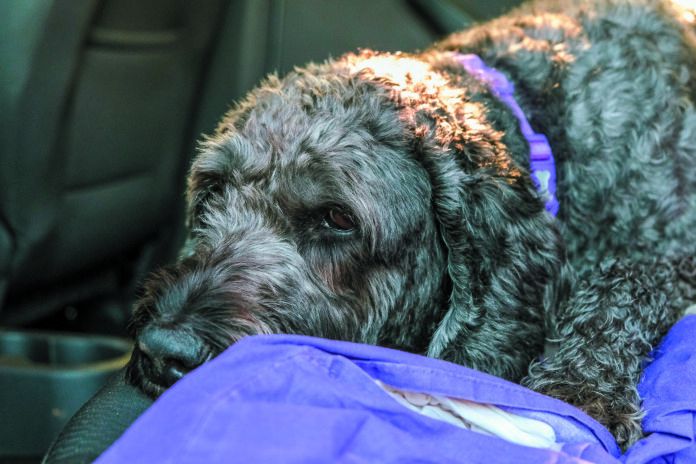The image of a dog sticking his head out the car window is iconic. Even though it’s unsafe because it means he’s not safely secured in his seat, most dogs love to feel the wind on their face as the vehicle rushes along. Yet a small but significant minority of dogs feel nauseated during car rides, literally. They hunker down for what’s going to be a grim experience. They whine, pace, or smack their lips. Some drool or vomit.
Is it actual motion sickness or, rather, anxiety about traveling in the auto? It takes some sleuthing to figure it out.
True motion sickness
True motion sickness, a physiological problem, tends to be an issue for puppies and other young dogs. The vestibular system, which includes the inner ear, is immature and therefore may not work properly to maintain a sense of balance. That’s what leads to the nausea.
In most cases, a dog grows out of motion sickness when his vestibular system catches up to the rest of his maturation. Sometimes the problem does persist into adulthood, but that’s the exception rather than the rule.
By considering a dog’s age in combination with his overall demeanor, a veterinarian can help you determine if motion sickness is responsible for the dog’s symptoms in the car.
Motion sickness treatment options. Fortunately, there are effective drugs that can quell symptoms. A good prescription drug is maropitant citrate. Its brand name is Cerenia, but it recently became available as a generic medication, which should bring down the price.
Over-the-counter antidotes include Dramamine (dimenhydrinate), meclizine, and certain antihistamines. But do not administer any OTC preparation — not even something like ginger — without your vet’s go-ahead and dosing advice depending on your dog’s weight and other health factors.
Anxiety about riding in the car
Many more dogs feel awful during car rides for emotional reasons rather than because of a vestibular system that is not yet fully acclimated. It could be that your pet had a bad experience that sensitized him. Perhaps he was transported in a van from far away right after being separated from his mother and litter mates. Maybe he only goes in the car when he gets taken to the vet, so the ride signals the beginning of an unpleasant experience. Whatever the cause of the anxiety, it can result in the same queasiness and cascade of other symptoms suffered by dogs with actual motion sickness.
Anxiety treatment options. Short-acting anti-anxiety medications that can help a dog feel calm during car rides comprise one option. But there are a number of other approaches that can help, too.
- Lower the car window a couple of inches, even in cold weather. Fresh air might help.
- Keep the car as cool as you can without feeling uncomfortable yourself. A hot, stuffy environment can keep nausea going.
- Don’t feed your dog for several hours before taking him for a ride.
- Consider keeping the dog in a crate that’s covered on all sides except the front. The blur of things whizzing by can make nausea worse.
You can also try for gradual desensitization. It takes time but can bear fruit.
Start by just interacting with your dog next to the car. Play with him, feed him, or just pet and coo over him. After several days of doing that, do it all with the car door open. Then, after a while, proceed to putting favorite toys or foods on the floor of the vehicle.
Once you can see your canine companion is comfortable going inside the car, try shutting the door and turning on the auto — but not going anywhere. When you do finally drive with your dog in the car, make it a very short trip to a place that he loves — the park, or perhaps the home of a friend with a dog he loves to play with. Ramp up to longer trips over time. The key to success is making sure that as you get your dog used to the car, he shows no signs of anxiety or fear during the desensitization process.
You may need a combination of behavioral and medication approaches, but eventually, your pet should be able to tolerate car rides much more easily. Remain patient, and never show frustration if your dog is having a hard time. That’s only going to set him back.






Another reason that I’ve heard about leaving a car window open a bit is to help lessen the pressure in the car as a result of the car moving (pushing) through the air especially at higher speeds. Cars do have pressure relief valves built in (those little grilles seen on the door openings) to prevent windshield blow outs in extreme outside heat with the windows shut and the car parked, but leaving the window partially open is far better at relieving internal car pressure plus more fresh air is moved through the car.